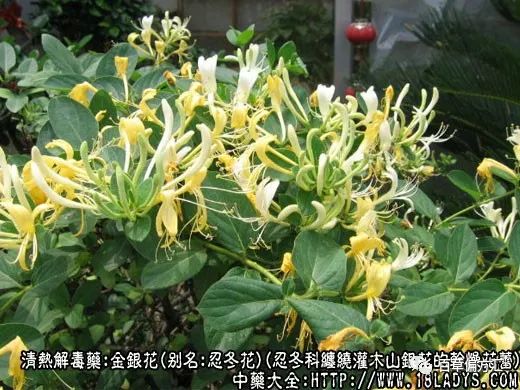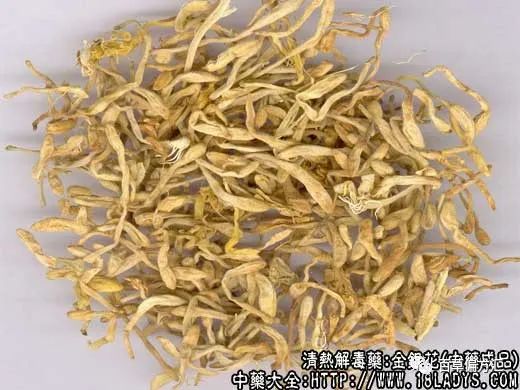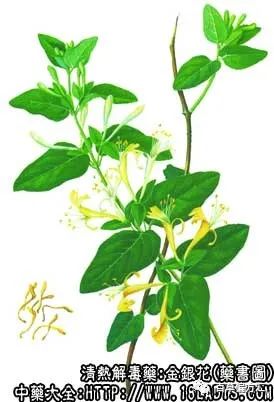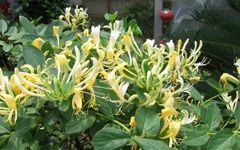Jin Yin Hua (Honeysuckle) is a commonly used Chinese medicinal herb. It features a flower with two blooms on one stem, one large and one small, first recorded in the Ben Cao Gang Mu under the category of Lonicera. Li Shizhen noted that this plant flowers in March and April, growing to about an inch long, with two blooms on one stem, one large and one small, and long stamens. Initially, the flowers and petals are white, turning yellow after two to three days, creating a contrast of yellow and white, hence the name “Jin Yin Hua” (Gold and Silver Flower).
 Image of Jin Yin Hua in cultivation
Image of Jin Yin Hua in cultivation
 Dried Jin Yin Hua
Dried Jin Yin Hua
Aliases: Jin Yin Hua, Shuang Hua, Er Hua, Ren Dong Hua, Er Bao Hua.
Source: It is derived from the dried flower buds of the perennial evergreen climbing shrub Lonicera japonica and other species within the same genus. It is mostly cultivated, with some wild varieties.
Production Areas: Nan Yin Hua (Mi Yin Hua) is primarily produced in Henan Province, including counties such as Mixian, Weishi, and Xingyang. It has the best quality but lower yield, mostly for export. Dong Yin Hua (Ji Yin Hua) is mainly produced in Shandong Province, including counties like Feixian, Pingyi, and Cangshan. It has good quality and higher yield, for both domestic and export markets. Shan Yin Hua (Tu Yin Hua) is widely produced in provinces such as Guangxi, Hunan, Guangdong, Hubei, Anhui, Sichuan, Zhejiang, Shaanxi, Jiangsu, Jiangxi, and Guizhou, with Guangxi and Hunan having larger outputs, also supplying non-producing areas.

Identification of Characteristics: Nan Yin Hua: The flower buds are rod-shaped and slightly curved, about 2-3 cm long, with the upper end having a diameter of about 3 mm and the lower end about 1 mm, with a blunt tip. The base often has gray-green small flower calyxes, five-lobed, about 3-5 mm long. The flower buds are yellow-white and densely covered with short hairs. When the flower buds are opened, five stamens and one pistil can be seen, and the fully opened flowers can reach up to 5 cm in length, with a lip-shaped corolla that is wrinkled and yellow-brown in color. It has a fragrant aroma with a slightly bitter taste, characterized by clear flower bud branches without open flowers, a thicker corolla with a firm texture, and a yellow-white color with a slight green hue, giving a firm feel when held.
Dong Yin Hua: The shape and taste are slightly similar to Nan Yin Hua, but the flower buds are slightly larger and lighter, often mixed with open flowers or occasional green leaves. The flower buds are yellow-white, and the open flowers are yellow-brown, with more pronounced curvature and disordered branches. It feels less firm when held.
Shan Yin Hua: The flower buds are also rod-shaped but thinner and yellow, sometimes with light green or brownish flowers that have opened. The entire structure is less hairy or not hairy at all, with a brittle texture that breaks easily when held, having a sweet aroma and a slightly sour and bitter taste.
All three types of Jin Yin Hua are best when the flower buds are plump, greenish-white or yellow-white, with few open flowers and no stem leaves.
Main Components: Contains inositol, luteolin, chlorogenic acid, tannins, etc.
Efficacy and Functions of Jin Yin Hua
It clears heat and detoxifies, with the following principles:
1. Antibacterial. In vitro experiments show that it has inhibitory effects on Staphylococcus aureus, hemolytic streptococcus, Shigella, Salmonella, meningococci, and pneumococci. Its alcohol extract at a concentration of 1:1,000,000 has an inhibitory effect on Mycobacterium tuberculosis, and single-use Jin Yin Hua has therapeutic effects on tuberculosis in mice. Overall, Jin Yin Hua is a potent broad-spectrum antibacterial herb.
2. Antiviral. Using the chicken embryo method for direct in vivo testing and preventive methods, it has been found to have antiviral effects against the influenza virus.
3. Antifungal. In vitro tests show that the water extract of Jin Yin Hua inhibits skin fungi such as Trichophyton rubrum.
4. Astringent. The tannins provide astringent effects, making Jin Yin Hua useful for acute enteritis.
5. Diuretic.
Additionally, preliminary animal experiments have found that the effective components of Jin Yin Hua can bind with cholesterol in vitro, reducing cholesterol absorption in the intestines of rabbits.
Preparation: Used raw or charred.
Properties: Sweet and cold.
Meridians: Enters the Lung, Heart, and Stomach meridians.
Functions: Clears heat and detoxifies. Charred form cools blood and stops bleeding.
Indications: For exterior wind-heat, acute febrile diseases, carbuncles, and toxic heat dysentery.
Clinical Applications: It is a commonly used herb for treating sores, dysentery, and exterior wind-heat febrile diseases.
1. For treating sores and carbuncles with redness, swelling, heat, and pain (belonging to “yang syndrome”), Jin Yin Hua is often indispensable due to its strong antibacterial properties. For mild cases, it can be combined with Lian Qiao (Forsythia) and Zi Hua Di Ding (Viola) in a formula like Jin Yin Hua Jie Du Tang (Honeysuckle Detoxifying Decoction); for more severe cases, such as early-stage carbuncles with significant pain but not yet ruptured, it is necessary to add Zhi Shan Jia (Manis) and Zao Jiao Ci (Gleditsia) to promote the dispersal or rupture of the abscess, as in the formula Xiao Chuang Yin (Sore Dispersing Decoction). After the carbuncles heal, if there is thirst, Jin Yin Hua can also be used to brew water instead of tea. It also has certain therapeutic effects on skin eczema and scabies.
2. For treating damp-heat dysentery (bacterial dysentery, acute enteritis, etc.), it can be combined with Huang Qin (Scutellaria), Yin Chen (Artemisia), and Bai Shao (Paeonia), or used alone in a concentrated decoction. If it is blood dysentery, then Jin Yin Hua Charred is required.
3. For treating exterior wind-heat or heat-invading diseases in the early stages, with symptoms on the surface such as fever, slight aversion to wind and cold, headache, and sore throat, it can be combined with Lian Qiao, Dan Dou Chi (Fermented Soybean), and Jing Jie (Schizonepeta) to clear heat and detoxify while dispersing wind and resolving the exterior, as in the formula Yin Qiao San (Honeysuckle and Forsythia Powder).
Dosage: The common dosage is 9-30g, with concentrated decoction for heat dysentery. For sores and carbuncles, the dosage is larger, generally 30g, and in severe cases, it can be used up to 60-90g per dose, with some using up to 120g.
Example Formulas: 1. Jin Yin Hua Jie Du Tang (Honeysuckle Detoxifying Decoction) from Yang Ke Xin De Ji: Jin Yin Hua 30g, Zi Hua Di Ding 20g, Chi Fu Ling 9g, Lian Qiao 9g, Dan Pi 6g, Huang Lian 4.5g, Xia Ku Cao 9g, Xi Jiao 1g, decoct in water.
2. Xiao Chuang Yin (Sore Dispersing Decoction) from Wai Ke Fa Hui: Jin Yin Hua 30g, Zhi Shan Jia 9g, Zao Jiao Ci 9g, Chi Shao 9g, Zhe Bei 9g, Fang Feng 6g, Bai Zhi 4.5g, Dang Gui Wei 12g, Ru Xiang 3g, Mo Yao 3g, Chen Pi 6g, Tian Hua Fen 12g, Gan Cao 6g, decoct in water. Occasionally, nausea and vomiting may occur after taking this formula, but it is not a concern.
3. Yin Qiao San (Honeysuckle and Forsythia Powder) from Wen Bing Tiao Bian: Jin Yin Hua 12g, Lian Qiao 9g, Jing Jie 9g, Dan Dou Chi 9g, Niu Bang Zi 9g, Jie Geng 6g, Bo He 3g (added last), Dan Zhu Ye 9g, Lu Gen 18g, Gan Cao 3g, decoct in water.
Note: Nan Yin Hua is usually harvested in April and May, preferably on sunny mornings, and immediately spread out on stones to dry. If it is cloudy, the harvested flower buds should be spread thinly on bamboo mats for ventilation and shade drying to maintain the bright color of the flower buds, resulting in better quality.
Dong Yin Hua has a larger yield and a stronger time sensitivity for harvesting. Due to insufficient labor, some flower buds may open before they can be harvested, leading to a chaotic collection process, often mixed with leaves, and not being dried quickly enough, resulting in inferior quality compared to Nan Yin Hua.
Shan Yin Hua is often found wild in various provinces in Jiangnan, with an earlier flowering period, harvested in March and April. During this time, the Jiangnan region enters the rainy season, and after collecting in the morning, it may take until afternoon to return home. The collected flower buds are often pressed into containers for a long time, and after being sold to supply and marketing cooperatives, they cannot be dried promptly due to rain, often being treated with sulfur smoke and then dried. During the smoking and drying process, the Jin Yin Hua becomes semi-cooked or fully cooked, losing its hairs and becoming gelatinous, hence the dried Shan Yin Hua appears less hairy, although microscopic examination may reveal remnants of hairs as small white spots.
Appendix: Ren Dong Teng.
Ren Dong Teng, also known as Jin Yin Teng, is the tender stem of the Lonicera plant in the Caprifoliaceae family. The stem is cylindrical and slender. The product often consists of several branches coiled into a bundle, with a diameter of about 1.5-6 mm. The outer skin is reddish-brown, and the exposed skin appears gray-green. The old stems are hairless and leafless. The young stems are often densely hairy and usually have oval opposite leaves, gray-green or yellow-green, often fragmented. The vine stems are brittle and easily break. The cross-section is gray-white or yellow-white, with a hollow pith, having a faint taste.
The best quality is characterized by uniform branches, reddish-brown inner skin, and tender texture with leaves.
Preparation: Cut into sections, used raw.
Effects: It has the same effects as Jin Yin Hua, additionally clearing wind-heat from the meridians and alleviating meridian pain.
Appendix: Jin Hua Teng (also known as Ren Dong Teng) has a weaker heat-clearing and detoxifying effect than Jin Yin Hua but has a stronger effect in dispelling wind and activating the meridians, commonly used for treating rheumatic pain, with a usual dosage of 12-30g.
Note: Across the country, Jin Yin Teng and Ren Dong Teng are considered the same herb, with tender stems with leaves being preferred. However, in Jiangsu and Zhejiang, they are differentiated into Jin Hua Teng and Ren Dong Teng, with tender branches with leaves referred to as Jin Hua Teng, while older, thicker branches with peeling skin are called Ren Dong.
More Exciting Recommendations:
Chinese Herbs: The Efficacy of Zi Su
Chinese Herbs: The Efficacy of Yin Chen
Chinese Herbs: The Efficacy and Functions of Ban Xia
Chinese Herbs: The Efficacy and Functions of Chui Pen Cao (6 Major Effects and Usage Methods)
The above contentis sourced from the internet,for reference only,please delete if infringing!
Follow your physician’s advice! Do not self-medicate! Be the first to collect and share with friends,the more people see it, the more health benefits!
Be the first to collect and share with friends,the more people see it, the more health benefits!

